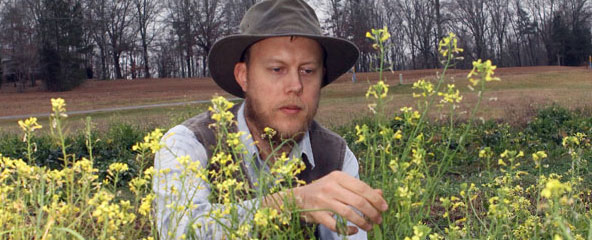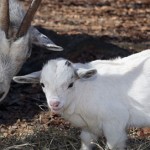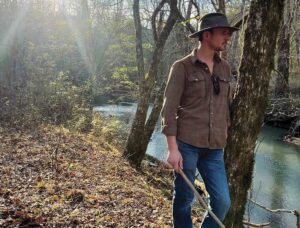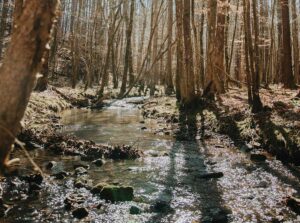
St. Clair forager finding culinary fame in Birmingham restaurants
 Story by Graham Hadley
Story by Graham Hadley
Photos by Jerry Martin
Where you see weeds, St. Clair’s Chris Bennett sees valuable food.
So valuable that he has been able to make a successful side business out of foraging for wild edibles and selling them to high-end restaurants in the Birmingham area.
His acumen for finding flavorful food in the wild is good enough, in fact, that some of Chris’ edibles were used by award-winning Chef Chris Hastings at the Hot and Hot Fish Club in Birmingham to prepare a meal for famous Chef Andrew Zimmern for an installment of his Travel Channel show Bizarre Foods.
The dish, called the Foragers Walk, included chickweed, Virginia pine, wild mushrooms, hoary bittercress, wild lettuce, cat’s ear dandelion, field mustards — “a lot of different stuff,” Chris said.
Most of that “stuff” Chris finds growing wild around his house.
Pointing to a small cluster of slender, dark-green stems poking out of the winter ground in a field near his house, Chris quickly identifies them as “field onions.” He breaks off a few of the stems and holds them to his nose, saying, “I just snip them off and use them as wild chives.
“They have a more aggressive flavor than regular chives. Why go to the store and buy chives when you can get these in your yard?”
And field onions are just the beginning. In just a couple of hours, he proceeds to identify all kinds of edible plants, all growing in winter within a few hundred yards of where he lives on his family’s old farm property in St. Clair not far from the Interstate 20 Chula Vista exit.
But, before he started showing off his talent for identifying wild edibles, or foraging, Chris was quick to point out that it took him years of research — studies that are always ongoing — before he was comfortable eating things he found growing in his yard and nearby fields and woods, let alone selling them to restaurants.

“People need to know … Rule Number 1 … make absolutely sure what you pick is edible. There are lots of tasty things in nature — but lots of stuff is poison,” he said.
It’s his knowledge of not only what is safe to eat, but how it tastes, that has created a market for Chris’ wild edibles in some of Birmingham’s finer dining establishments.
You can’t just walk up to a chef and say, “Look what I found in the woods” and have them buy it. You have to build a reputation for your product and also be able to speak their “language.”
For Chris, that is easy today — he has worked in restaurants all over the country, from Richmond, Va., to Chicago to Birmingham.
He grew up in St. Clair County, on the very property he now forages on — though it was an 84-acre cattle farm back then — before leaving for college to earn a business degree. He knew he did not like traditional farming and had discovered a love and talent for cooking.
“I grew up on the farm, but hated doing chores. I would rather be off having adventures in the woods. Back then, in the 1980s, you could still walk down the road and pick blackberries — which you really can’t anymore,” he said.
After college, “when I lived in Richmond, I got into cooking, I got more into food; got more into gardening,” he said.
And though he describes himself as an omnivore now — “I will pretty much eat anything” — Chris said he was a practicing vegetarian for a while, which made him pay more attention to what he was eating, reading ingredients labels more carefully.
That love of the outdoors, ability in the kitchen and growing interest in more wholesome foods combined to give Chris the foundation he needed to begin foraging.
“When I lived in Chicago, I read up on a lot of European chefs. They use a lot of wild edible plants. I learned there was a lot more out there than wild mushrooms,” he said. “There are things out there all around us.”
In 2005, Chris returned to Alabama to get the old family farm up and running. But he did not want to do traditional farming. Cultivating the land for foraging did away with a lot of the farm labor that did not interest him and allowed Chris to focus on his new passion.
Though he has a regular “day” job working as a cheese buyer for Whole Foods in Birmingham, Chris makes time to gather and sell his wild edible “finds” to restaurants.
Because he not only knows what is edible, he knows how it will taste, Chris can tell chefs exactly what edibles go with what dishes and how they can be prepared.
“I never sell anything I have not eaten,” he said. “My cooking background lets me tell them how to use it, how to cook it — or serve it raw, how it tastes.”
He also helps the restaurants keep track of what wild edibles are in season. “They come to me and ask is something still in season — like wild persimmons. Those are gone by now.”
As a case in point, Chris walks over to a cluster of what look like tall, leafy weeds with small, bright-yellow flowers on top.
“Wild edibles are mostly considered weeds by people who see them growing up in a yard or field. …”
This group of yellow flowering “weeds” grew where Chris had planted tomatoes and covered the ground with hay. “These plants came up. I am always looking at what things are. These, the leafs look like greens and the flowers look like Brassica” (a genus of plants that includes a number of vegetables, including mustards and cabbages).
“I finally figured out they are field mustard,” he said.
Chris uses several tools to help him identify new plants. He always carries a small bound notebook with him where he writes down everything about what he has found, sketches pictures, even takes pressings of the plants.
And, while he still relies on several books, Chris is quick to take advantage of modern technology to help him — using his iPhone to take pictures of the plants and Google and other online tools to identify them.
“It takes a while to learn what something is,” he said, reiterating, “People need to know — make absolutely sure what you pick is edible.” He also said it is equally important to know about where you are picking — since fertilizers and pesticides used in fields can be toxic, and some of the plants will actually draw heavy metals and other harmful chemicals up out of contaminated soil.
Chris is more than ready to help with that — organizing classes on his farm several times a year where he takes people out and teaches them his foraging skills.
People can check out his class schedule and sign up on his website and blog: hollowspringfarm.blogspot.com. He also uses the site as a way to spread information about what is in season and anything new he has found.
Which, despite the time he has spent roaming his family property, still happens frequently.
Walking across the road to another field that is part of the farm, Chris says, “I have been back here around eight years, and I am still finding new things.”
Pointing all around one side of the field, he identifies a number of small plants that make up a wild strawberry patch he uncovered after cutting the field. Though not in season now, when the plants produce fruit, they are what Chris describes as some of the best, most flavorful tiny strawberries you can find.
“They will ruin you for eating regular strawberries,” he said.
Another one of his favorite plants — a tree actually — borders the field. Chris strips off some needles from a Virginia pine and rolls them in his hands, producing a surprisingly strong citrus scent, with a hint of pine in the background.
“I make tea with the needles. It has a clean, pine flavor, but you can infuse it into any kind of liquid, everything from vodka to milk, even make a meringue with it.”
And, like many of the plants he gathers, the pine needles are good for you as more than just an edible, often containing high levels of vitamin C, especially in the winter.
“If I am starting to feel sick — I make tea with this,” he said, pointing out that many pine species have edible needles, but the complex citrusy-pine flavor makes the Virginia pine his favorite.
Chris has found and grows all sorts of other plants on the farm — sage, herbs, kale, cardoon (similar to an artichoke), chickweed (tastes like a pea pod), wild lettuce (which has the classic lettuce bitterness and is less tough than a dandelion green) — the list goes on and on.
And it keeps growing. Chris is always on the lookout for new edibles.
“You never know what you are going to find,” he said.


































